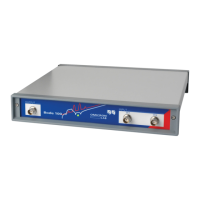Bode 100 User Manual
42
Hint: If you want to display the reflection in VSWR format select the VSWR
output format under Reflection as shown below.
Usually, the reference resistance of 50 Ω is used to calculate the reflection
coefficient and the VSWR. The Reference Resistance box allows you to enter
other reference resistance values if required.
The parallel and serial equivalent circuits give us an indication of the electrical
components that would be required to rebuild the electrical characteristics of
your DUT at the measurement frequency. In our example you would require a
39 nF capacitor and a 52.7 Ω resistor to build the series equivalent circuit.
Try it out, get yourself the required components and repeat the measurement. If
the results do not match 100% keep in mind that you are using real components
with a factor on their own.
For information on how to calibrate the Bode 100 in the Impedance/Reflection
mode, see 7.4 "Calibration in the Impedance/Reflection Mode" on page 83.
Congratulation! You learned how to use the Impedance/Reflection mode.
How to:
• Measure the reflection coefficient at a frequency
• Set the bandwidth and amplitudes used for the measurement
• Connect the DUT for the impedance and reflection measurement
• Optimize the diagrams
• Understand serial and parallel equivalent circuits
After this example get a
glass of water to
increase your reflection
mode and your attention
bandwidth. Then try
things out and right-click
and left-click to
everything that does not
move on the screen.
Go back to the overview chart at 4 "Impedance/Reflection Mode" on page 33
and try things out.
Q

